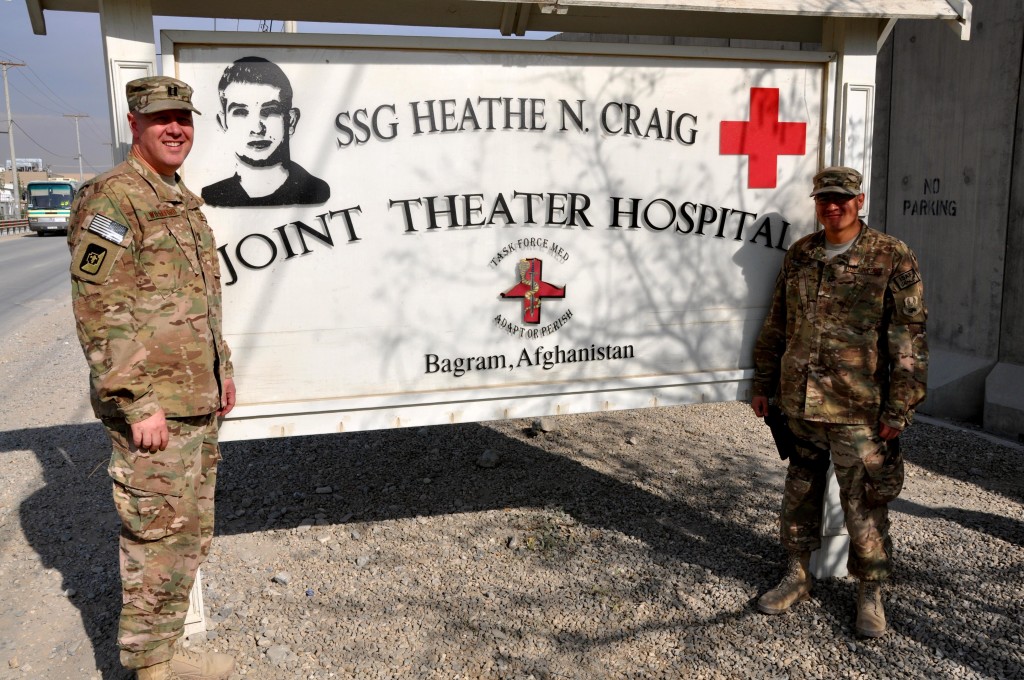Two sets of Air Force chaplains and chaplain assistants, known as religious support teams, or RSTs, provide religious support and spiritual counsel to this group of U.S. service members, International Coalition Forces and local nationals.
“It’s the unseen scars that we deal with,” said Chaplain (Capt.) Gary Willeford, a member of the hospital RSTs. “Issues of faith may come up with the traumas that they have experienced. We come alongside of our patients and remind them that God has not forgotten them in the midst of their crisis.”
“We are faced with many different patients from different cultures and faith backgrounds,” Willeford added. “We try to treat each one with respect and honor their faith and culture by showing them kindness.”
This approach extends to even the most unique patients, those who are considered enemies. Willeford recalls hearing an injured Taliban soldier communicating concern for his personal safety to his interpreter as he was being treated in the trauma bay.
“Being a patient in the trauma bay is hard enough. You are naked and laying on a bed with medical folks poking and prodding,” Willeford said. “Doctors take a Hippocratic oath to do no harm, but the enemy does not expect compassion. After he realized they were going to do everything they could to take care of him, he incessantly thanked the nurses and doctors for not killing him.”
For U.S. forces in particular, the Air Force RSTs have found a great way to connect with service members; they do this by helping them connect to their social networks.
“We provide mini laptops that have access to the WiFi network,” said Chaplain (Capt.) Michael Johnson. “The laptops are very popular with the patients because they provide means for the patients to communicate to friends and family, often for the first time since being admitted, via Skype, instant messaging, Facebook or email.”
But often, something even simpler than Internet connection does the job to provide comfort to service members in pain.
“I’m usually one of the first ones they see at Craig Joint Theater Hospital since I respond to all traumas in the trauma bay,” said Chaplain Assistant Tech. Sgt. Brian J. Ramirez. “When wounded warriors come in the trauma bay they are usually in pain and scared. I’ve seen many times an instant comfort come over them as the chaplain is praying for them.”
“The most difficult part is letting (service members) work through the grief process in their own way,” Johnson said. “Some of the challenges are in ministering to those who come in from improvised explosive device blasts. Many of them have lost limbs and are beginning to realize that their lives will be drastically different. Sometimes they are still grieving the buddies they just lost.”
For these caregivers, who work alternating 12-hour shifts, compassion fatigue is a very real threat. Also called secondary traumatic stress, compassion fatigue can affect individuals exposed to trauma and suffering, and can result in anxiety, stress and a feeling of hopelessness.
Working long and stressful shifts, the RSTs recognize that they need to carefully monitor their own well-being so they can effectively take care of others.
“We need chaplains too,” Johnson said. “Interaction between day and night shift can be as much about processing the events of the day as it is about turnover. It helps to have a chaplain that is experiencing the same things to be able to relate to and process with.”
The fact that each chaplain and chaplain assistant operates as a team means they always have a partner to work through whatever challenges their shifts may bring.
“I have a chaplain assistant that goes with me on my entire visitation,” Willeford said. “When I am especially hit hard with someone’s situation, we talk and are able to release our stresses by prayer and just talking it through.”
As caregivers to the ill and severely injured in a combat zone, the medical staff and RSTs work together to help patients heal inside and out. For those who have experienced trauma and loss, the chaplains and chaplain assistants seek to provide comfort and hope through prayer and counsel.
“It reminds me of our frailty and our resilience,” Willeford said. “We all need to be cared for and are dependent upon one another for our health and welfare. It reminds me of the hope we have in God when sometimes a situation that looked like there was no hope turns and hope is reborn. No matter what our physical condition is we have a purpose and make a difference in the world.”





